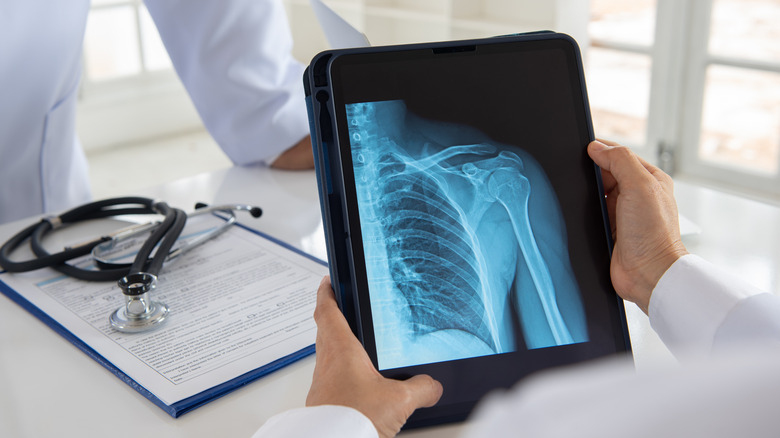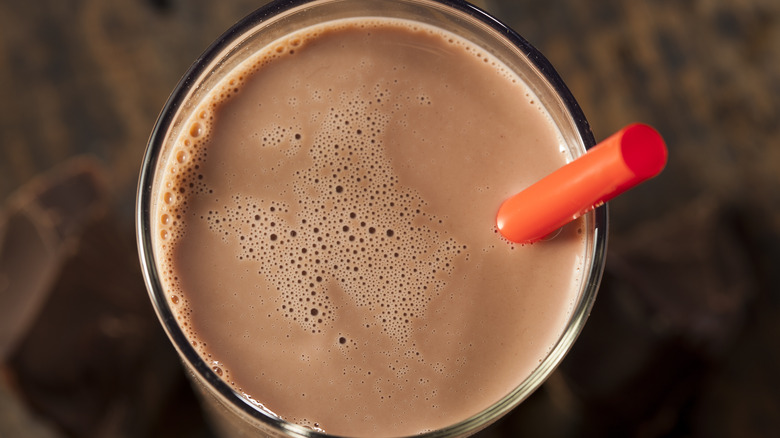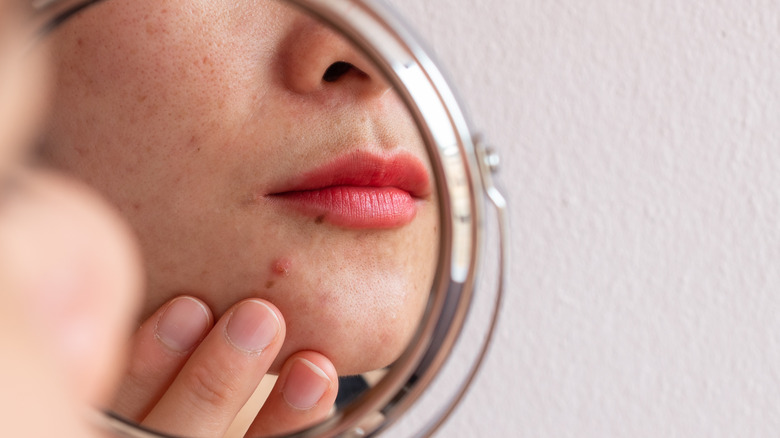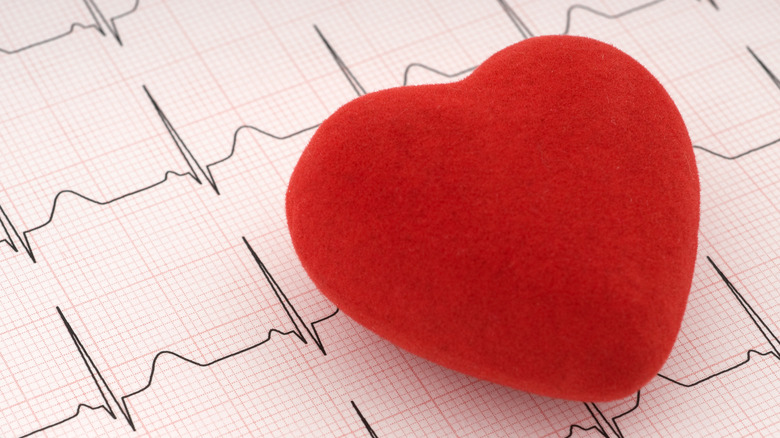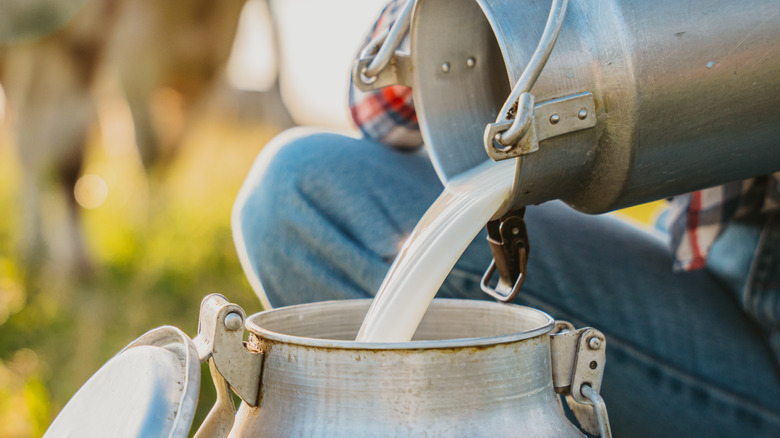What Happens To Your Body When You Drink Milk Every Day
If you go to the supermarket, you'll see a variety of products that have the word "milk" in their names, including plant-based milks like almond and soy. According to the Food and Drug Administration (FDA), certain foods are allowed to call themselves milk, as long as they indicated their plant source (via NBC).
With that said, if you think things are a lot simpler when you focus on just cow's milk, think again. As Harvard notes, there's whole milk, which is approximately 13% fat, carbs, vitamins, minerals, and protein. But there are also reduced fat, low fat, and nonfat milks, with 2%, 1%, and virtually zero milkfat, respectively. Disregarding their fat content, cow milk can also come in organic, raw or unpasteurized, and A2 varieties.
So, exactly how much cow's milk should a person be drinking? The U.S. Department of Agriculture (USDA) explains that there are factors to consider when determining how much dairy to consume each day, including one's height and weight, age, sex, and level of physical activity. Keep reading to find out what happens to your body when you drink cow's milk on a daily basis.
Your body will get a boost of calcium
As Harvard points out, one of the first things that comes to mind about calcium is that it's good for one's bones. In fact, all but 1% of the calcium in our bodies is in our bones. So, since a cup of milk has approximately 300 milligrams of calcium (according to the University of California San Francisco), milk must be essential for bone health, right? Well, it's a little more complicated than that.
Undoubtedly, calcium is important for your bones. And if there isn't enough calcium in the blood, the bones will release their calcium to compensate, which would seem to point to drinking milk in order to keep blood calcium levels normal. However, as Stanford nutrition scientist Dr. Christopher Gardner notes, "There are countries like Japan and India where the population is predominantly lactose-intolerant, where milk intake is low and hip fracture rates are also low. But many of those cultures do more weight-bearing activities than Americans." According to Dr. Gardner, being physically active may actually be more beneficial to your bone strength than simply relying on milk consumption.
The bottom line is that while milk can help keep your bones healthy as part of your diet, its calcium content alone won't be enough to guarantee strong bones.
Your muscles might recover better from workouts
According to registered dietitian Julia Zumpano, milk can give your body a boost if you're lacking in protein (via Cleveland Clinic). Protein is crucial for building and repairing muscles, as well as recovering more quickly from physical activity.
Interestingly, some studies have concluded that chocolate milk might be a good post-workout drink, per the University of Arkansas for Medical Sciences (UAMS). Its protein content appears to be a key factor: A cup of chocolate milk can have as much as 11 grams of protein. It's also good for rehydrating, contains sodium, and has nutrients like vitamin D and calcium. Plus, chocolate milk has twice the carbs of plain milk, which can be good for muscles during recovery.
In spite of its possible benefits, UAMS' Dr. Jorge Rodriguez, who is certified in treating sports injuries, noted that the amount of time you spend exercising is an important consideration when it comes to choosing what to drink following a workout. Chocolate milk is loaded with not just proteins but also carbs and calories, so if you're working out for less than an hour, it probably has more than what you actually need. Additionally, WebMD points out that the added sugars and calories in chocolate milk can make it harder to maintain a healthy weight.
You might experience more acne breakouts
Does milk cause acne? According to Shanna Miranti, a certified physician assistant at Riverchase Dermatology and Cosmetic Surgery, "Dairy, or any food for that matter, does not cause acne per se." However, Miranti cautions that dairy consumption could worsen your acne if you are already prone to having it.
Experts still aren't 100% sure why consuming milk or dairy products and having acne breakouts can go hand in hand. One possible explanation is that milk can cause inflammation, which is "present during the entire process of acne development." There's also the fact that milk contains sugar; drinking large amounts of it could contribute to blood sugar spikes, which can not only increase inflammation but also affect a substance called sebum. As Medical News Today notes, our sebaceous glands produce sebum — and too much of it, along with dead skin cells, can lead to acne.
Additionally, milk contains hormones that, as Miranti states, "play a big role in stimulating acne in people of all ages." Cows are sometimes given artificial growth hormones to increase milk production. With that said, cows that are not given additional hormones naturally produce them (meaning organic milk isn't exactly hormone-free). Regardless, we still can't say with absolute certainty that hormones in milk are the catalysts of acne breakouts.
It might affect your blood pressure
According to the Centers for Disease Control and Prevention (CDC), as your heart pumps blood, the blood pushes against the walls of your arteries. This force against your arteries is your blood pressure, and when it's "higher than normal," it's known as hypertension or high blood pressure. Hypertension is connected to health problems like strokes and heart attacks, and while diet can help with high blood pressure, there are both positive and negative aspects to milk when it comes to this health condition.
As registered dietitian Staci Nix McIntosh told the University of Utah Health, nutrients like calcium, magnesium, and potassium — which are found in milk — can help regulate or reduce blood pressure levels. Blood vessels need to tighten and relax at different points during the circulatory process. Calcium helps with the tightening part; both calcium and magnesium positively affect the relaxing part (via Harvard). Meanwhile, potassium contributes by "[helping] to ease tension in your blood vessel walls," per the American Heart Association.
In addition, foods that contain potassium can help your body get rid of sodium. However, as Nao Medical notes, milk also contains large amounts of sodium, which could make it a bad choice for someone with hypertension.
Milk might impact cholesterol management
As Johns Hopkins Medicine explains, our bodies need cholesterol. However, higher-than-normal amounts of low-density lipoprotein (LDL) cholesterol, or "bad" cholesterol, can lead to clogged arteries and dangerous health problems like heart attack and stroke. While diet can play a role in cholesterol management, there are mixed findings about milk and cholesterol.
According to Harvard, the saturated fat found in whole milk can increase not just LDL cholesterol, but also high-density lipoprotein (HDL) or "good" cholesterol. Conversely, a 2021 study in the International Journal of Obesity concluded that regular milk consumption may actually lower both LDL and HDL cholesterol (per Science Daily). Vimal Karani, study co-author and Professor of Nutrigenetics and Nutrigenomics at the University of Reading, clarified that they still weren't sure whether fat content or an "unknown 'milk factor'" was responsible for the lower cholesterol levels they observed.
The American Heart Association states that lower-fat milks generally have less saturated fat and cholesterol content than whole milk. With that said, if you're more than 20 years old, Johns Hopkins recommends having your cholesterol checked no less than every five years, whether or not you're a regular milk drinker.
You'll increase your intake of vitamin D
According to the National Institutes of Health (NIH) Office of Dietary Supplements, nearly the entire milk supply of the United States contains approximately 3 micrograms of vitamin D per cup. While calcium is important for strong bones, vitamin D makes it easier for our bodies to absorb calcium.
As Yale explains, food manufacturers began adding vitamin D to foods like milk in the 1930s because of a disease called rickets. This illness affects children's bones, making them soft and deformed (per NIH Office of Dietary Supplements). A vitamin D deficiency can lead to rickets, as well as osteomalacia, a disorder of the bones and muscles that affects both teenagers and adults.
Vitamin D deficiency is connected to health issues; however, too much vitamin D can also be bad for one's health, possibly even fatal. Among the three sources of vitamin D — the sun, supplements, and vitamin D-rich foods – the most common reason behind very high levels of vitamin D is excessive ingestion of vitamin D supplements. Signs of high vitamin D can include excessive urination, muscle weakness, nausea, and vomiting.
You could experience stomach issues
As the Mayo Clinic explains, stomach issues like diarrhea, gas, and bloating are sometimes the result of an individual being lactose intolerant (i.e., not being able to completely break down lactose, a sugar found in milk). However, Medical News Today points out that these same stomach problems might be because of something else in the milk besides lactose.
Milk contains a kind of protein called casein. Specifically, it has beta-casein, which comes in two variants: A1 and A2. Typically, when you buy milk at the supermarket, you're going to get something that contains both A1 and A2 beta-casein, although it'll probably have more A1 than A2. This might be where the true digestive issues lie for some patients: When your body breaks down A1, it makes beta-casomorphin-7 (BCM-7), a peptide that may trigger the same symptoms as lactose does in lactose-intolerant individuals.
However, it is possible to buy A2 milk, which, as the name suggests, only has A2 beta-casein. Still, although A2 milk might help someone who is having an adverse reaction to BCM-7, that doesn't guarantee it will help everyone with dairy-related stomach issues. A2 milk doesn't contain A1 beta-casein, but it does have lactose, meaning it can trigger gas, bloating, and diarrhea in lactose-intolerant individuals.
You could get sick from raw milk
Per the CDC, pasteurizing milk involves heating it, which kills viruses, bacteria, and parasites. When milk isn't pasteurized, it's referred to as raw milk, which the CDC describes as "one of the riskiest foods." Raw milk may contain pathogens like E. coli and Salmonella.
There are claims that pasteurizing milk destroys healthy bacteria and nutrients (via WebMD). However, the CDC debunks this notion, emphasizing that the process "doesn't change the milk's nutritional value." Moreover, there is more than one way germs can contaminate milk. For example, if a cow is sick, the germs that made it sick can be found in its milk as well. Germs can also come from an animal's skin or feces, or even the equipment used to milk the animal. Additionally, testing raw milk for germs isn't foolproof; it's possible for milk to have low levels of germs which might not come up on a test.
Besides the possible health risks, WebMD notes that there are states in the U.S. where it's illegal to sell raw milk to consumers. Lastly, foods like ice cream, soft cheese, and yogurt can also cause severe health problems if they are made from raw milk (per CDC).


